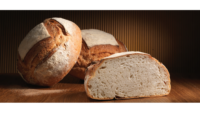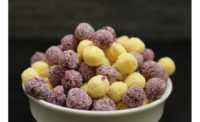Sugar is now squarely top of mind for consumers. According to the 2019 International Food Information Council (IFIC) “Food & Health” survey, limiting sugar intake is one of the top ways in which consumer diets have changed over the past several years, and 80 percent of consumers are trying to limit and/or avoid added sugars. Consumers are much more cognizant of sugar and added sugar, and the U.S. globally ranks as having the highest average daily sugar consumption. According to IFIC, the current average sugar consumption in the U.S. is 25.28 teaspoons per day, which is 11.98 teaspoons more than the U.S. government recommends. IFIC also states that 90 percent of people in the U.S. exceed the Dietary Guidelines recommendation to limit calories from added sugar to no more than 10 percent of calories per day.
The FDA has issued new guidelines for Nutrition Facts labelling. This includes making calorie declarations more prominent and adding the amount and daily value percentage for “added sugars” on the label so this information is more transparent, ostensibly enabling consumers to make better, more-informed choices. This new labelling mandate to include added sugars took effect on January 1, 2020.
The combination of rising consumer concerns coupled with increased regulatory pressures is going to keep sugar reduction a priority for many companies.
Sweet updates
Consumers are gravitating to more natural foods and ingredients, including sweeteners. Briess Malt & Ingredients Co., Chilton, WI, recently launched BriesSweet Oat extract, as well as an organic version of Innosweet whole grain oat powder, to help give product developers more options. “Similar to malt extract, our oat extract product is made simply and naturally by cooking whole grain oats in water in the presence of enzymes which break the starch down to simpler sugars,” says Bob Hansen, technical director. “Insoluble fiber and protein are gently filtered out, and the unrefined juice is concentrated to a shelf-stable syrup. Because BriesSweet Oat extract is unrefined, it still contains much of the original nutrition of the whole-grain oats. In fact, besides soluble vitamins and minerals, it contains 25 percent of the original beta-glucan—about 5 grams of plant-based protein per 100 grams. Oat extract provides humectancy and binding and works great in soft bars, cookies, brownies and other sweet sacks. Because of its reducing sugars and amino acids, it acts as a browning agent and can be also be used in baked snacks that need better browning such as bagels and bagel chips, breadsticks and pretzels.” The oat extract can be used by itself or in combination with other sweeteners, like evaporated cane juice, in applications such as oatmeal cookies.
“Organic Innosweet is made by sprouting whole wheat and slowly cooking it to develop sugars. The grain is ground into flour, but nothing is removed, so it remains a whole-grain ingredient with all its original nutrition. It can be used to increase nutritional value of traditional baked goods while supplying some sweetness. It contains about 12 grams of plant protein per 100 grams,” notes Hansen. Since the ingredient is a whole food, the naturally present sugars are not considered added sugars and do not have to be declared as such on the Nutrition Facts panel.
Organic Innosweet can be used to replace refined sugar in low-sugar baked products like breads. In higher-sugar bakery formulations, it can be used with other sweeteners, as the ingredient’s functionality is closer to flour than sugar.
Malt Products Corp., Saddle Brook, NJ, recently introduced Golden Trim Molasses. “Golden Trim Molasses, a replacement for dextrose, offers an aromatic flavor that masks undesirable off-notes from additives such as protein isolates. Compared with traditional molasses, Golden Trim is smooth and with honey overtones and caramel notes. True to its name, it is also lighter than most molasses products,” notes Amy Targan, president.
Golden Trim Molasses offers a range of benefits. As a natural humectant and antioxidant, it helps improve shelf life in baked goods. Golden Trim is also an excellent binder for granola bars. Across a wide range of bakery products, the ingredient provides an appealing brown color. It’s also a good source of beneficial nutrients such as calcium and potassium, and is non-GMO project verified. The sweetener can be used alone or in tandem with other sweeteners, such as tapioca or rice syrups.
The National Honey Board, Longmont, CO, notes that it’s seeing more bakeries reformulate products to use honey, highlighting its status as a natural sweetener. Based on a 2018 online study conducted by Kerry and shared by the National Honey Board, honey was rated the No. 1 sweetener in terms of awareness, perception and preference as a natural sweetening agent. The same study cites that 64 percent of consumers prefer honey as a natural sweetener. “Honey is all-natural and is actually one of the few all-natural sweeteners that does not undergo significant processing,” says Catherine Barry, director of marketing.
“Honey is made by bees, and beekeepers extract and package the honey without adding anything to it or concentrating the ingredient,” says Barry. “In addition to providing great flavor and sweetness, honey also performs countless functional roles in bakery foods. Honey is composed mostly of fructose and glucose, making it 10–50 percent sweeter than sugar. This may allow a product developer to use honey to reduce the overall amount of sweetener ingredients used in a formula. Honey also acts as a natural shelf-life extender. The ingredient’s fructose content helps clean-label breads hold in moisture and naturally extends shelf life. This reduces dryness and crumbliness of bakery foods, making for a more-acceptable finished product.”
Better blends
Several sugar alternatives have seen growth over the past few years. According to Innova Market Insights, new product launches that mentioned stevia grew an average of 13 percent each year from 2014–2018, and is continuing to see growth. New product launches using monk fruit increased on average 21 percent per year.
Allulose is a rare sugar that is found in small quantities in foods like figs and jackfruit. The FDA recently ruled that allulose does not have to be included as part added sugars on the Nutrition Facts panel.
Thom King, CEO and president, Icon Foods, Portland, OR, says allulose is one of the most-exciting novel sweeteners he has seen in 20 years. Icon Foods recently launched a new sweetener called IconiSweet that’s a blend of allulose, erythritol, stevia and monk fruit.
“Allulose is a saccharide and functions like sugar,” says King. “It burns easily and goes into Maillard quickly, so we have added erythritol to suppress those characteristics. Both of these sweeteners are about 70 percent as sweet as sugar, so we added stevia and monk fruit to bring it to parity with sugar. Stevia and monk fruit have properties that mask each other’s off-notes. IconiSweet is perfect for bread and cookie formulations thanks to erythritol that lowers water activity, thereby extending shelf life. It also participates in the Maillard reaction, giving bread and cookies a golden hue.”
Cargill, Minneapolis, takes a holistic and balanced approach to sugar reduction to deliver the right taste and texture. “To replace sugar’s sweetness, we often recommend Cargill’s ViaTech stevia leaf extract,” says Matt Gennrich, senior food technologist, R&D bakery applications. “It offers improved sweetness and flavor dynamics compared with earlier reb A stevia options, enabling greater sugar reductions in a wide array of bakery applications. However, because sugar delivers so much functionality to baked goods and snacks, we usually recommend combining ViaTech with Zerose erythritol and Oliggo-Fiber chicory root fiber. These bulking agents help deliver the tenderness and mouthfeel consumers expect. In many bakery applications, this trio of ingredients can successfully replace 15 to 20 percent of the sugar in cookies and 20 to 50 percent of the sugar in cakes and muffins, with little effect on overall product performance.” All three of these ingredients are non-GMO.
Cargill has a broad portfolio of other ingredients that can be used to help find the right balance of sweetness, taste and texture, including native starches, reduced-sugar corn syrups, corn syrup solids, tapioca syrup and maltodextrins, to name a few.
Ingredion Incorporated, Westchester, IL, offers a few sweetening solutions to help snack food producers and bakers reduce their sugar impact. Joanne Wang, sweetener technical service customer solutions, outlines their respective features and benefits:
- VERSASWEET low sugar corn or tapioca-based glucose syrups:
- One-third as sweet as sucrose, with a 50–70 percent lower percentage of mono- and disaccharides when compared to traditional glucose syrups
- Stable to heat and acid and has low Maillard reactivity
- Clean taste, clear in color
- ASTRAEA allulose:
- 70 percent as sweet as sugar, with similar taste with no off-notes
- Contributes only 0.4 calories per gram to formulations
- Not counted as part of total and added sugars
- Provides functional bulking and browning
Both ingredients are suitable for cookies, breads, muffins, bars, bakery fillings and granola clusters and can work either alone or in combination with other ingredients such as high-potency sweeteners or liquid fibers.




